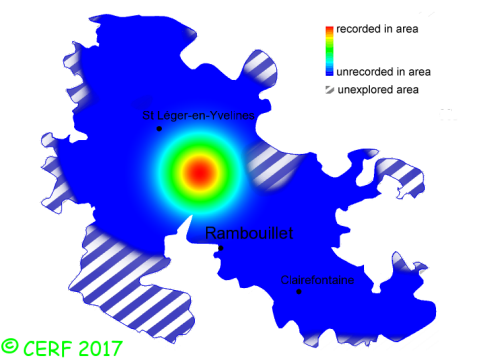|
Psathyrella artemisiae (Pass.) Konrad & Maubl.
|
common name(s) : Petticoat Brittlestem
New classification: Basidiomycota/Agaricomycotina/Agaricomycetes/Agaricomycetidae/Agaricales/Psathyrellaceae
Former classification: Basidiomycota/Homobasidiomycetes/Agaricomycetideae/Agaricales/Coprinaceae
synonyms: Drosophila squamosa, Psathyrella squamosa, Psathyrella gossypina ss.Rick., Psathyrella jerdonii ss.Romagn.
edibility : unknown edibility
|
|
|
The cap is brownish when damp, pale beige otherwise, hemispherical then conical to convex, with a central umbo; its margin is covered with persistent white woolly fibrils (hanging veil debris).
The cap surface is covered with white woolly fibrils, turning smooth and more scaly towards margin with age, not viscid nor sticky.
The stem is white, thin, with a short-lived ring zone.
The flesh is whitish to brownish, unchanging; its taste is faint, mild; the odour is not distinctive;
its texture is fibrous.
The gills are pales then dark brown, broadly adnate, not very crowded (nb of gills per 90° ~ 13 ).
The spore print is purple brown. This species is saprophytic.
It grows on wood or on the ground, in broad-leaved or mixed woods, on wood debris, buried or not, on a rather acid soil.
The fruiting period takes place from May to November.
| Dimensions: | width of cap approximately 3 cm (between 1.5 and 4 cm) |
| | height of stem approximately 5 cm (between 3 and 6 cm) |
| | thickness of stem (at largest section) approximately 4 mm (between 2 and 5 mm) |
Chemical tests : none.
Distinctive features : brown to pale beige cap, hygrophanous, with woolly-silky fibrils especially towards margin; grey then brown gills, with a white edge; on dead wood
Psathyrella artemisiae is rare and confined in the forest of Rambouillet, and is occasional, more generally speaking
.
|  | | Above : distribution map of Psathyrella artemisiae in the forest of Rambouillet |
|
page updated on 14/01/18
